#'game development with Pacific Power'
Explore tagged Tumblr posts
Video
Oh man, probably looked better before Unity shat themselves
♬ Just announced: Tue Oct 10, 5:30pm: SF GAME DEVELOPMENT MEETUP https://www.dnalounge.com/calendar/2023/10-10a.html #dnalounge #sfgamedevelopmentmeetup #sanfrancisco
SF Game Development Meetup: SF Game Development is excited to partner with HashiCorp and Unity. HashiConf is happening this week, and this is one of the exclusive after hours events that you’ll get to attend for FREE. Food is sponsored by HashiCorp and drinks are available for purchase at the DNA Lounge bar. Speakers will go on stage at 7:00pm. This event is open to the public and is a professional networking event for game developers, artists, students, indies, or really anyone interested in game development.
#Unity#unity engine#game dev#DNA Lounge#HashiCorp#what does HashiCorp even do#that would related to game dev?#I mean yeah#you might run HashiCorp stuff for your infrastructure#but that's like...#IDK#'game development with Pacific Power'#because you use electricity from them to run the office#San Francisco#I wonder if JWZ will be there#and be his grumpy ex-dev self about it#that would be great#he wouldn't grump too much about something bringing money in though
2 notes
·
View notes
Text
Unraveling India’s BRICS and BRI Conundrum
In a world where geopolitics often resembles a complex game of 3D chess, India finds itself pondering its next move on a board set by two ambitious projects – the expansion of BRICS and China’s Belt and Road Initiative (BRI). Imagine a chessboard, not with mere black and white squares, but a vibrant mosaic of global interests, strategic rivalries, and the occasional pawn aspiring to be a queen.…
youtube
View On WordPress
#2023#BRICS expansion#China&039;s Belt and Road Initiative#diplomatic challenges#economic alliances#economic corridors#emerging economies#geopolitical chess game#geopolitical irony#Geopolitics#global power dynamics#Global-Strategy#India&039;s-Foreign-Policy#India-BRICS relations#India-China rivalry#Indo-Pacific affairs#infrastructure development#international diplomacy#multipolar world order#Pakistan-BRICS membership#regional influence#sovereignty concerns#strategic-partnerships#Youtube
0 notes
Text
Masterpost: Reasons I firmly believe we will beat climate change
Posts are in reverse chronological order (by post date, not article date), mostly taken from my "climate change" tag, which I went through all the way back to the literal beginning of my blog. Will update periodically.
Especially big deal articles/posts are in bold.
Big picture:
Mature trees offer hope in world of rising emissions (x)
Spying from space: How satellites can help identify and rein in a potent climate pollutant (x)
Good news: Tiny urban green spaces can cool cities and save lives (x)
Conservation and economic development go hand in hand, more often than expected (x)
The exponential growth of solar power will change the world (x)
Sun Machines: Solar, an energy that gets cheaper and cheaper, is going to be huge (x)
Wealthy nations finally deliver promised climate aid, as calls for more equitable funding for poor countries grow (x)
For Earth Day 2024, experts are spreading optimism – not doom. Here's why. (x)
Opinion: I’m a Climate Scientist. I’m Not Screaming Into the Void Anymore. (x)
The World’s Forests Are Doing Much Better Than We Think (x)
‘Staggering’ green growth gives hope for 1.5C, says global energy chief (x)
Beyond Catastrophe: A New Climate Reality Is Coming Into View (x)
Young Forests Capture Carbon Quicker than Previously Thought (x)
Yes, climate change can be beaten by 2050. Here's how. (x)
Soil improvements could keep planet within 1.5C heating target, research shows (x)
The global treaty to save the ozone layer has also slowed Arctic ice melt (x)
The doomers are wrong about humanity’s future — and its past (x)
Scientists Find Methane is Actually Offsetting 30% of its Own Heating Effect on Planet (x)
Are debt-for-climate swaps finally taking off? (x)
High seas treaty: historic deal to protect international waters finally reached at UN (x)
How Could Positive ‘Tipping Points’ Accelerate Climate Action? (x)
Specific examples:
Environmental Campaigners Celebrate As Labour Ends Tory Ban On New Onshore Wind Projects (x)
Private firms are driving a revolution in solar power in Africa (x)
How the small Pacific island nation of Vanuatu drastically cut plastic pollution (x)
Rewilding sites have seen 400% increase in jobs since 2008, research finds [Scotland] (x)
The American Climate Corps take flight, with most jobs based in the West (x)
Waste Heat Generated from Electronics to Warm Finnish City in Winter Thanks to Groundbreaking Thermal Energy Project (x)
Climate protection is now a human right — and lawsuits will follow [European Union] (x)
A new EU ecocide law ‘marks the end of impunity for environmental criminals’ (x)
Solar hits a renewable energy milestone not seen since WWII [United States] (x)
These are the climate grannies. They’ll do whatever it takes to protect their grandchildren. [United States and Native American Nations] (x)
Century of Tree Planting Stalls the Warming Effects in the Eastern United States, Says Study (x)
Chart: Wind and solar are closing in on fossil fuels in the EU (x)
UK use of gas and coal for electricity at lowest since 1957, figures show (x)
Countries That Generate 100% Renewable Energy Electricity (x)
Indigenous advocacy leads to largest dam removal project in US history [United States and Native American Nations] (x)
India’s clean energy transition is rapidly underway, benefiting the entire world (x)
China is set to shatter its wind and solar target five years early, new report finds (x)
‘Game changing’: spate of US lawsuits calls big oil to account for climate crisis (x)
Largest-ever data set collection shows how coral reefs can survive climate change (x)
The Biggest Climate Bill of Your Life - But What Does It DO? [United States] (x)
Good Climate News: Headline Roundup April 1st through April 15th, 2023 (x)
How agroforestry can restore degraded lands and provide income in the Amazon (x) [Brazil]
Loss of Climate-Crucial Mangrove Forests Has Slowed to Near-Negligable Amount Worldwide, Report Hails (x)
Agroecology schools help communities restore degraded land in Guatemala (x)
Climate adaptation:
Solar-powered generators pull clean drinking water 'from thin air,' aiding communities in need: 'It transforms lives' (x)
‘Sponge’ Cities Combat Urban Flooding by Letting Nature Do the Work [China] (x)
Indian Engineers Tackle Water Shortages with Star Wars Tech in Kerala (x)
A green roof or rooftop solar? You can combine them in a biosolar roof — boosting both biodiversity and power output (x)
Global death tolls from natural disasters have actually plummeted over the last century (x)
Los Angeles Just Proved How Spongy a City Can Be (x)
This city turns sewage into drinking water in 24 hours. The concept is catching on [Namibia] (x)
Plants teach their offspring how to adapt to climate change, scientists find (x)
Resurrecting Climate-Resilient Rice in India (x)
Other Masterposts:
Going carbon negative and how we're going to fix global heating (x)
#climate change#climate crisis#climate action#climate emergency#climate anxiety#climate solutions#fossil fuels#pollution#carbon emissions#solar power#wind power#trees#forests#tree planting#biodiversity#natural disasters#renewables#renewable electricity#united states#china#india#indigenous nations#european union#plant biology#brazil#uk#vanuatu#scotland#england#methane
2K notes
·
View notes
Text
‘When In Rome’ doesn’t seem all that important of an episode at first. But then you realize Xena basically commissioned Gabrielle to kill Crassus. It’s painful cause you know Gabrielle is a person that genuinely does appreciate human life and won’t kill just for the sake of it. If it can be avoided, she will avoid it. Yet, she’s forced to decide time and time again for what to do in the heat of the moment and the conclusion seems to always be for somebody to die. Whether it be herself, Xena or other, and sometimes even at her own hand. She said she accepted the consequences of living her life with Xena early in their travels together, but I don’t think she accounted for the fact she’d have to kill just to keep her and Xena alive. Or, like in the case of this episode, to save Vercinix, a good, innocent man and a hero to his people, from being executed at the order of Caesar. It wasn’t just about sacrificing her own life, it was also sacrificing and betraying everything she stood for so that her and Xena could survive. Season 4 was the storyline for this. Choosing pacifism because she believed it was the right Way for her, then breaking it again when Xena was left vulnerable and defenceless and she had no other option but to make that split-second decision to kill those soldiers that were going to kill her. It was inevitable the way she’d end up. Whether it is a good thing or not is up to you and how you perceive the situations that happen within the episodes. Your better judgement.
This is the life Gabrielle chose. To experience and face all the violence, blood and pain again and again, being just as much a partaker in it as trying to stop it from happening… Just to be with Xena. That’s got to be the most tragically romantic, beautiful and powerful thing I’ve ever known. I’ve said it before and I’ll say it again. Xena and Gabrielle truly are the greatest love story ever told, and I’m not just saying it because they’re my OTP. I’ll be damned if I ever find anything more romantic than Gabrielle’s insistence to throw away her morality for Xena. She’s going against her own sense of self time and again just to protect and defend people’s lives. Especially Xena’s. It’s a testament to how much and how deeply she really loves her and that’s so incredibly romantic. Wouldn’t you agree?
This is another episode where no one really cares about the Xena/Caesar fued. This episode belongs to Gabrielle and her struggle to betray her ideals by personally sending Crassus to the executioner. Commissioned and expected to by Xena, no less.
She's the heart of the whole story here. It all wraps tightly around her.
Just like 'The Deliverer', without what's going on with Gabrielle, it's just another cat-and-mouse Xena VS Caesar game and even though I love the Rome episodes, they're not as interesting as you think they are without Gabrielle’s stuff. And as great as all the other writers are with Gabrielle’s representation and development, only Steven truly gets what Gabrielle’s about. Him and Renee really make this show resonate far beyond a villain-turned-hero seeking redemption story.
Without Gabrielle - this show is half its watch value. Well and truly.
#xena warrior princess#when in rome...#commentary#xena#lucy lawless#gabrielle#renee o'connor#steven l. sears#exclusive bonus content
85 notes
·
View notes
Text
Like a Dragon: Pirate Yakuza in Hawaii announced for PS5, Xbox Series, PS4, Xbox One, and PC - Gematsu
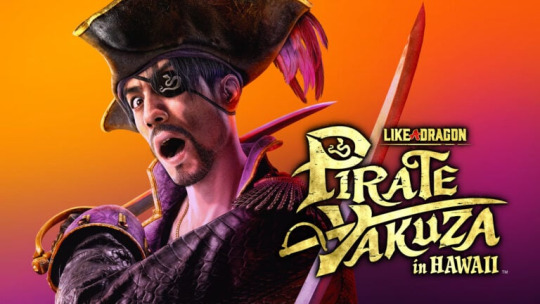
Publisher SEGA and developer Ryu Ga Gotoku Studio have announced Like a Dragon: Pirate Yakuza in Hawaii for PlayStation 5, Xbox Series, PlayStation 4, Xbox One, and PC (Steam, Microsoft Store). It will launch on February 28, 2025 worldwide.
Get the first details below.
■ About the Game
A new legend begins as you step into the steel toe boots of Goro Majima, a man who has lost his memory and reinvents himself as a pirate on the open sea. Embark on an over-the-top, modern-day pirate adventure with an ex-yakuza, now pirate captain and his crew as they engage in exhilarating combat on land and sea in the hunt for lost memories and a legendary treasure.
Pirate Yakuza Adventure��Ahoy!
Goro Majima, a notorious ex-yakuza suddenly finds himself shipwrecked on a remote island in the Pacific. Unable to remember even his own name, he sets sail in search of clues to his lost memories, accompanied by a boy named Noah who saved his life. Before long, they’re caught up in a conflict between cutthroat criminals, modern-day pirates, and other scoundrels over a legendary treasure.
Get Your Ship Together
Assemble a one-of-a-kind crew while upgrading your ship as you explore the open sea and forge your legend in the cannon fire of foes, unexpected friendships, and immense riches made along the way. When an enemy pirate ship catches you in their sights, an exhilarating real-time cannon battle breaks out. Quickly maneuver into position while avoiding fire, then deliver devastating damage to board the enemy ship and take down the captain in all-out crew vs. crew brawls. Conquer the seas, discover hidden islands and acquire loads of loot like a true yakuza pirate!
Kick Arrrss With Creative Combat
Dynamically switch between the “Mad Dog” and “Pirate” fighting styles to mix-up attacks and deliver explosive combos, juggles, and aerial takedowns that reward your creativity with over-the-top action. With “Mad Dog” style, utilize speed, agility, and flair to deliver precise yet powerful blows that stun your enemies into submission. Or make enemies walk the plank with the “Pirate” style that has you dual-wielding short swords and deploying tricky pirate tools to kick some serious booty.
■ Story
After losing his memory, Goro Majima, a once-feared legend in the yakuza world, sets sail in search of treasure. Half a year ago teaming up with Kiryu for a massive battle in the Millenium Tower, Goro Majima washes up with the wreckage of a boat on the shore of a remote, sparsely populated island. With no memories—not even his own name—Majima joins forces with Noah, the young islander who saved his life, and embarks on a search for clues to his forgotten past. However, what waits for them is a powder-keg world where scoundrels vie for a legendary treasure.
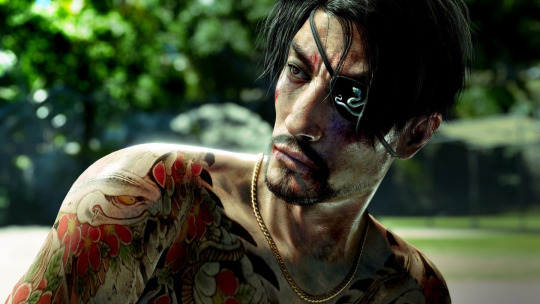
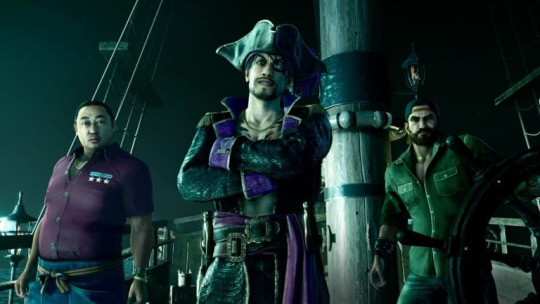
■ Cast
Goro Majima (voiced by Hidenari Ugaki)
Patriarch of the former Tojo Clan’s Majima Family.
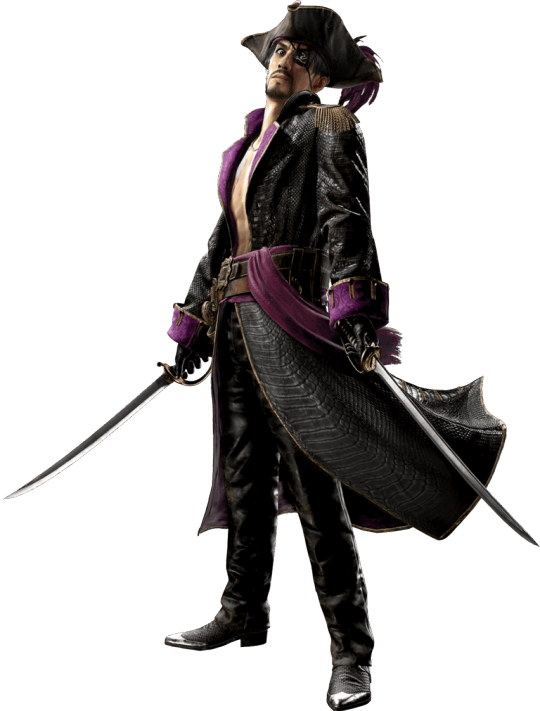

An ex-yakuza with no memories who has washed ashore on a remote island.
Noah Rich (voiced by First Summer Uika)
Local boy on Rich Island.

A youth who dreams of the outside world, hoping to leave the confines of Rich Island.
Jason Rich (voiced by Kenji Matsuda)
Bar Owner on Rich Island and Noah’s father.

A former treasure hunter who, despite being a drunkard, is still a true sea dog.
Masaru Fujita (voiced by Ryuji Akiyama (Robert))
Bodyguard and ship cook.

A skilled chef for hire who’s sailed the seas on a long line of pirate ships.
Teruhiko Shigaki (voiced by Munetaka Aoki)
Patriarch of the former Tojo Clan’s Shigaki family.
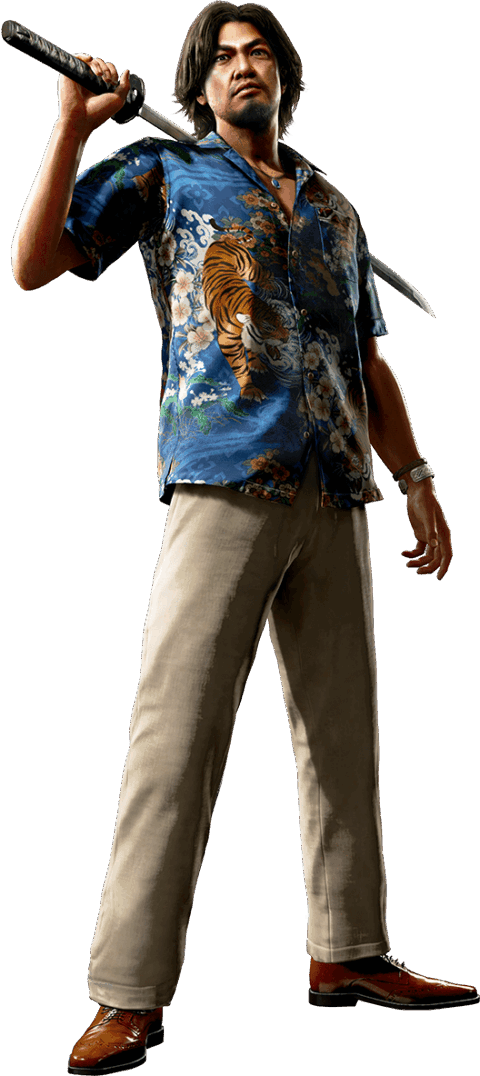
An ex-yakuza with no memories who has washed ashore on a remote island.
Rodriguez (voiced by Ayumi Tanida)
Palekana disciple.
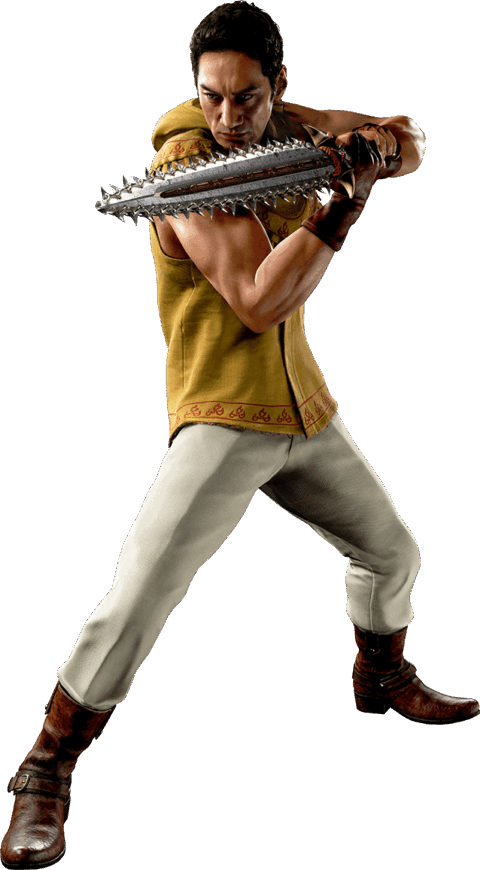
A burly warrior who guards Nele Island, Palekana’s holy site, with his massive sword.
Mortimer (voiced by Shunsuke Daitoh)
Head of the Mortimer Armada.

A handsome pirate with a charismatic persona who inspires fervor in the lowlifes around him.
Goro (voiced by ???)
Noah’s little friend.

An adorable little cat (?) that Noah found on Rich Island.
■ Battle
Push Combat to the Extreme with Two Battle Styles
In addition to his signature Mad Dog style, which is all about speed, Majima can also use his new Sea Dog style to wield a cutlass and other buccaneer gear. Pick the style that works for you to kick, pummel, and slash your way through the filthy bilge rats who stand in your way!
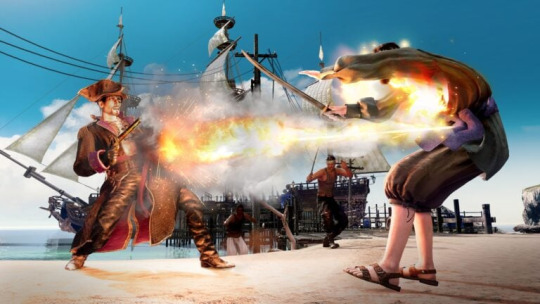


■ Adventure
Go wild and unleash chaos around the waters of Hawaii as Goro Majima!
Rich Island
A remote island that an amnesiac Goro Majima washes up on. Noah and his family are some of the island’s few inhabitants. Despite fishing being the mainstay of the local economy, pirates reminiscent of the Age of Discovery can be inexplicably seen sauntering around.
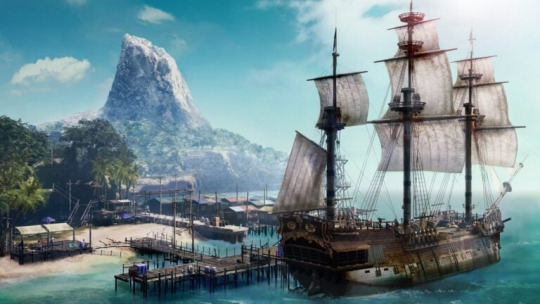
Madlantis
A secret island where multiple criminal organizations coexist. In a cave on the island hides a sprawling pleasure district built around a fleet of massive tankers. The Pirates’ Coliseum, a hub where pirates constantly engage in naval battles, is here.

Nele Island
A holy site of Palekana, a long-standing religious group based in Hawaii. The Haku, the most fervent believers of Palekana, inhabit the island. The island is notably larger than Rich Island and has a proper harbor.
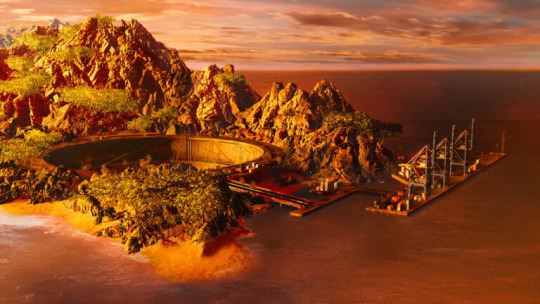
Hawaii
One of the world’s most famous tourist destinations. You can learn a lot about Hawaii from the owner of a bar called Revolve in Honolulu City.

■ Early Purchase Bonus
Ichiban Pirate Crew Set
Crew Member: Ichiban Kasuga
Backup Crew: Nancy
Ichiban Special Outfit Set
Kasuga Outfit (Infinite Wealth)
Kasuga Outfit (Yakuza: Like a Dragon)
■ Game Editions
Standard Edition (physical / digital) – $59.99 / £54.99 / €59.99 / 6,930 yen
A copy of Like a Dragon: Pirate Yakuza in Hawaii
Deluxe Edition (digital) – $74.99 / £64.99 / €74.99 / 8,690 yen
A copy of Like a Dragon: Pirate Yakuza in Hawaii
Downloadable content
Legendary Pirate Crew Pack – Have Kazuma Kiryu, Daigo Dojima, and other fan-favorite Like a Dragon characters become shipmates with the Goro Pirates!
Legendary Outfit Pack – Give Majima more outfits to wear, including a T-shirt exclusively designed for this title and the iconic get-ups sported by yakuza legends such as Kazuma Kiryu and Taiga Saejima.
Ship Customization Pack – Personalize the appearance of your pirate ship, the Goromaru! Choose from designs based on popular characters from the franchise, including Kazuma Kiryu and Ichiban Kasuga.
Extra Karaoke and CD Pack – Add the Majima Construction Song to karaoke and gain the option to play karaoke staples while exploring.
Complete Box (Japan / Asia) (physical) – 19,800 yen
A copy of Like a Dragon: Pirate Yakuza in Hawaii
Goro Majima Pop-Up Pirate Jr.
Goro Majima Eyepatch
Like a Dragon: Pirate Yakuza in Hawaii acrylic art board (A4 size)
Art book
Downloadable content
Legendary Pirate Crew Pack – Have Kazuma Kiryu, Daigo Dojima, and other fan-favorite Like a Dragon characters become shipmates with the Goro Pirates!
Legendary Outfit Pack – Give Majima more outfits to wear, including a T-shirt exclusively designed for this title and the iconic get-ups sported by yakuza legends such as Kazuma Kiryu and Taiga Saejima.
Ship Customization Pack – Personalize the appearance of your pirate ship, the Goromaru! Choose from designs based on popular characters from the franchise, including Kazuma Kiryu and Ichiban Kasuga.
Extra Karaoke and CD Pack – Add the Majima Construction Song to karaoke and gain the option to play karaoke staples while exploring.
Watch the announcement trailer, battle gameplay, and reveal event archive below. View the first screenshots at the gallery. Visit the official website here: English / English (Asia) / here.
Announce Trailer
English
youtube
Japanese
youtube
Battle Gameplay
English
youtube
Japanese
youtube
RGG Summit 2024
English
youtube
Japanese
youtube
#Like a Dragon: Pirate Yakuza in Hawaii#Like a Dragon#Yakuza series#Ryu Ga Gotoku#Sega#Ryu Ga Gotoku Studio#Goro Majima#Gematsu#Majima's coming for yer booty. XP
39 notes
·
View notes
Note
Top five locations you’d like to see a Fallout video game set in? Also, hi Nico. It’s me, Michael! It’s been a while since we last spoke, huh?
Hi ^_^ it’s been a while
I’d love to see a game set in the Pacific Northwest in the post-New Vegas ending where the Khans build an empire there.
Given the fact that weird wet/swampy areas have without fail contributed to the best of Bethesdout’s DLC, I think they should lean in and set a full game somewhere like the Bayou or the Everglades.
I dunno if it has the legs for a full length game, but Alaska as one of the biggest fronts of the Great War and also something miles and miles from the established parts of the setting might be interesting to ex-post-facto explore the impacts of living near the front of a ground war in the setting, and so the writers can’t crutch so hard on the NCR and Brotherhood.
I still think there’s a lot of potential to be explored in the southwest still, explore some post-collapse former Legion areas and see what life looked like in the more domestic regions of Legion territory, what remains post collapse and what’s rushed into fill the power vacuum.
I really like the New Vegas dynamic of “one massive city and the communities living in its shadow” where you spend the early game circling its outer rim; I think a similar interesting dynamic might be to set the game in the Twin Cities in Minnesota, with two not necessarily outright hostile but opposed factions controlling each city where you get to explore all the communities caught in between (sort of like NV if the Legion had been developed more).
The big Caveat is “I want the writers to be better than they have been”. If we’re going to Alaska and talking about war there, I’d want to see the game discuss indigeneity and imperialism at least somewhat, I’d like any game returning to the southwest to be a little lest chowderheaded about Hispanic people, I’d like a little more judicious use of the Brotherhood even if I recognize they’re here to stay.. well. Pie in the sky innit
8 notes
·
View notes
Text

New SpaceTime out Wednesday
SpaceTime 20240828 Series 27 Episode 104
The alien big Wow signal finally solved – maybe!
A new study may have finally narrowed down the likely source of the famous big Wow signal.




Cluster mission set to come to a fiery end over the South Pacific
On September the eighth the first of four satellites that make up the European Space Agency’s Cluster mission will re-enter Earth’s atmosphere and burn up over the South Pacific Ocean.






Planet Earth hit by another powerful solar storm
The Earth’s been pummelled by more violent solar storms erupting out of the Sun including several powerful X class solar flares.






The Science Report
Eating higher levels of plant fats lowers your chances of developing heart disease or dying early.
Claims drugs containing Semaglutide could increase your risk of suicidal thoughts.
Playing video games for less than three hours daily may have a positive effect on your mental.
Alex on Tech the cyborgs are here.
SpaceTime covers the latest news in astronomy & space sciences.
The show is available every Monday, Wednesday and Friday through Apple Podcasts (itunes), Stitcher, Google Podcast, Pocketcasts, SoundCloud, Bitez.com, YouTube, your favourite podcast download provider, and from www.spacetimewithstuartgary.com
SpaceTime is also broadcast through the National Science Foundation on Science Zone Radio and on both i-heart Radio and Tune-In Radio.
SpaceTime daily news blog: http://spacetimewithstuartgary.tumblr.com/
SpaceTime facebook: www.facebook.com/spacetimewithstuartgary
SpaceTime Instagram @spacetimewithstuartgary
SpaceTime twitter feed @stuartgary
SpaceTime YouTube: @SpaceTimewithStuartGary
SpaceTime -- A brief history
SpaceTime is Australia’s most popular and respected astronomy and space science news program – averaging over two million downloads every year. We’re also number five in the United States. The show reports on the latest stories and discoveries making news in astronomy, space flight, and science. SpaceTime features weekly interviews with leading Australian scientists about their research. The show began life in 1995 as ‘StarStuff’ on the Australian Broadcasting Corporation’s (ABC) NewsRadio network. Award winning investigative reporter Stuart Gary created the program during more than fifteen years as NewsRadio’s evening anchor and Science Editor. Gary’s always loved science. He studied astronomy at university and was invited to undertake a PHD in astrophysics, but instead focused on his career in journalism and radio broadcasting. Gary’s radio career stretches back some 34 years including 26 at the ABC. He worked as an announcer and music DJ in commercial radio, before becoming a journalist and eventually joining ABC News and Current Affairs. He was part of the team that set up ABC NewsRadio and became one of its first on air presenters. When asked to put his science background to use, Gary developed StarStuff which he wrote, produced and hosted, consistently achieving 9 per cent of the national Australian radio audience based on the ABC’s Nielsen ratings survey figures for the five major Australian metro markets: Sydney, Melbourne, Brisbane, Adelaide, and Perth. The StarStuff podcast was published on line by ABC Science -- achieving over 1.3 million downloads annually. However, after some 20 years, the show finally wrapped up in December 2015 following ABC funding cuts, and a redirection of available finances to increase sports and horse racing coverage. Rather than continue with the ABC, Gary resigned so that he could keep the show going independently. StarStuff was rebranded as “SpaceTime”, with the first episode being broadcast in February 2016. Over the years, SpaceTime has grown, more than doubling its former ABC audience numbers and expanding to include new segments such as the Science Report -- which provides a wrap of general science news, weekly skeptical science features, special reports looking at the latest computer and technology news, and Skywatch – which provides a monthly guide to the night skies. The show is published three times weekly (every Monday, Wednesday and Friday) and available from the United States National Science Foundation on Science Zone Radio, and through both i-heart Radio and Tune-In Radio.
#science#space#astronomy#physics#news#nasa#astrophysics#esa#spacetimewithstuartgary#starstuff#spacetime#jwst#hubble space telescope#james webb space telescope
9 notes
·
View notes
Text
Not to complain about tri stamp on main, genuinely NOT trying to bash it, but I really don't like how they handled Vash and Knives relationship :/ . And it's not just bc it's different from the source material. Specifically rn thinking about the arm situation.
Rambling thoughts on why below:
On the surface, it's the same- there's a confrontation between the brothers and it ends with Knives cutting off Vash's arm. But like the implications are so different 😭. In stamp, they argue bc Knives just "protected" Vash by killing some humans, Vash's powers start to go haywire in a fit of protective rage, and Knives takes Vash's arm to keep him from black holing everything. But the manga situation frames it in a much more interesting way to me. They're arguing bc Knives just killed humans to "save" Vash again, BUT
1) these humans did actually hurt Vash. It's not all that unreasonable to retaliate when the evidence of their cruelty is right there in a young Vash chained to a pole in the town square. But Vash would never retaliate bc of his pacifism and the fact that he understands why they have done something cruel. He would get pissed at Knives killing any humans of course, but the pre-established relationship Vash has with these people in particular gives the reader a different picture of WHY Vash chooses pacifism. He's not just "uwu all humans are good", he knows intimately that they can be cruel but he believes strongly in their ability to change-- they're cruel bc they were backed into a corner, that means there's another path forward for them, the cruelty is not inevitable, they all have blank tickets. Meanwhile in stamp, those random scientists were not cruel to Vash. Yeah, scientists as a whole shunned him and spoke bad about him at first, but Vash has a well-established, friendly working relationship by that point. Taking away the immediacy of the cruelty frames Knives as the more mature one who sees past the humans' front to see how they're taking advantage of Vash and it frames Vash as the naive one who must learn why he should protect people instead of turning a blind eye to their cruelty. And like I get why Orange probably did this-- it's a more conventional story beat and gives room to show Vash's development from a naive kid to the wiser hero. But idk I just think this is boring compared to trimax's approach where our expectations for Vash to be the naive hero (like wolfwood's expectations) are slowly chipped away as we learn that Vash is actually a deeply thoughtful, mature person. Much more mature compared to Knives, whose philosophy of killing everything that can hurt you is shown to be deeply childish and naive.
Which leads me to 2) Knives in trimax did not cut off Vash's arm to save or protect him. Even if you can argue stamp Knives did it more to save himself than save Vash, there's still external benefits to keeping Vash from black holing everything uncontrollably lol. But there is NO hiding why manga Knives did it. It was a pure, petty, childish fit of rage. Vash tries to shoot him and Knives is pissed that Vash isn't doing what he wants, that he's standing up to Knives. Vash isn't playing the game how Knives insists it must be played and Knives is a kid who can't regulate his emotions so he lashes out when he doesn't get his way. This is one of the most transparent moments for who Knives is as a person. And I think it's one of the most crucial scenes in the series for showing the main point: that cruelty is childish and cannot bring about a better world and kindness and mercy are the harder road that take real maturity to truly believe in.
Anways, all that being said I don't hate stamp. I can tell that Orange does genuinely have a lot of love for trimax and trigun as a whole and they had to make a lot of simplifying adaptational choices to even conceivably fit the charm of a story as deceptively introspective as trigun into 12 episodes. But still, the places they chose to simplify just don't work for me. I think they make the story much more bland, unfortunately. If I were to watch stamp completely blind, I don't think I would be all that interested in the Vash Knives conflict bc it's a narrative I've seen a hundred times before. And I just think that's a shame, because I could write paragraphs and paragraphs more on how interesting their relationship in the manga is and I wish more people could be exposed to that story.
#trigun#trigun meta#genuinely not trying to take the wind out of any 23 anime enjoyers sails here. if u love it dont let me convince u otherwise#i just have a lot of thoughts about stamp as an adaptation and why it doesn't work for me :/#i think orange always does an incredible job in the art and animation dept#which is a great fit for trimax where people's main gripe tends to be that nightow's chaotic art style in the fight scenes is hard to follo#but i've had issues with adaptational story choices they've made in all their adaptations so far. i think they simplify stuff too much#i might just notice it w/ orange more since they seem to love picking series w/ deep thoughtful stories that dont have a lot of fluff to cu#anyways this is a separate ramble now lol#i dont know what the solution is here so this is really just me complaining ¯\_(ツ)_/¯
13 notes
·
View notes
Text
In a future conflict, American troops will direct the newest war machines not with sprawling control panels or sci-fi-inspired touchscreens, but controls familiar to anyone who grew up with an Xbox or PlayStation in their home.
Over the past several years, the US Defense Department has been gradually integrating what appear to be variants of the Freedom of Movement Control Unit (FMCU) handsets as the primary control units for a variety of advanced weapons systems, according to publicly available imagery published to the department’s Defense Visual Information Distribution System media hub.
Those systems include the new Navy Marine Corps Expeditionary Ship Interdiction System (NMESIS) launcher, a Joint Light Tactical Vehicle–based anti-ship missile system designed to fire the new Naval Strike Missile that’s essential to the Marine Corps’ plans for a notional future war with China in the Indo-Pacific; the Army’s new Maneuver-Short Range Air Defense (M-SHORAD) system that, bristling with FIM-92 Stinger and AGM-114 Hellfire missiles and a 30-mm chain gun mounted on a Stryker infantry fighting vehicle, is seen as a critical anti-air capability in a potential clash with Russia in Eastern Europe; the Air Force’s MRAP-based Recovery of Air Bases Denied by Ordnance (RADBO) truck that uses a laser to clear away improvised explosive devices and other unexploded munitions; and the Humvee-mounted High Energy Laser-Expeditionary (HELEX) laser weapon system currently undergoing testing by the Marine Corps.
The FMCU has also been employed on a variety of experimental unmanned vehicles, and according to a 2023 Navy contract, the system will be integral to the operation of the AN/SAY-3A Electro-Optic Sensor System (or “I-Stalker”) that’s designed to help the service’s future Constellation-class guided-missile frigates track and engage incoming threats.
Produced since 2008 by Measurement Systems Inc. (MSI), a subsidiary of British defense contractor Ultra that specializes in human-machine interfaces, the FMCU offers a similar form factor to the standard Xbox or PlayStation controller but with a ruggedized design intended to safeguard its sensitive electronics against whatever hostile environs American service members may find themselves in. A longtime developer of joysticks used on various US naval systems and aircraft, MSI has served as a subcontractor to major defense “primes” like General Atomics, Boeing, Lockheed Martin, and BAE Systems to provide the handheld control units for “various aircraft and vehicle programs,” according to information compiled by federal contracting software GovTribe.
“With the foresight to recognize the form factor that would be most accessible to today’s warfighters, [Ultra] has continued to make the FMCU one of the most highly configurable and powerful controllers available today,” according to Ultra. (The company did not respond to multiple requests for comment from WIRED.)
The endlessly customizable FMCU isn’t totally new technology: According to Ultra, the system has been in use since at least 2010 to operate the now-sundowned Navy’s MQ-8 Fire Scout unmanned autonomous helicopter and the Ground Based Operational Surveillance System (GBOSS) that the Army and Marine Corps have both employed throughout the global war on terror. But the recent proliferation of the handset across sophisticated new weapon platforms reflects a growing trend in the US military towards controls that aren’t just uniquely tactile or ergonomic in their operation, but inherently familiar to the next generation of potential warfighters before they ever even sign up to serve.
“For RADBO, the operators are generally a much younger audience,” an Air Force spokesman tells WIRED. “Therefore, utilizing a PlayStation or Xbox type of controller such as the FMCU seems to be a natural transition for the gaming generation.”
Indeed, that the US military is adopting specially built video-game-style controllers may appear unsurprising: The various service branches have long experimented with commercial off-the-shelf console handsets for operating novel systems. The Army and Marine Corps have for more than a decade used Xbox controllers to operate small unmanned vehicles, from ground units employed for explosive ordnance disposal to airborne drones, as well as larger assets like the M1075 Palletized Loading System logistics vehicle. Meanwhile, the “photonics mast” that has replaced the traditional periscope on the Navy’s new Virginia-class submarines uses the same inexpensive Xbox handset, as does the service’s Multifunctional Automated Repair System robot that’s employed on surface warships to address everything from in-theater battle damage repair to shipyard maintenance.
This trend is also prevalent among defense industry players angling for fresh Pentagon contracts: Look no further than the LOCUST Laser Weapon System developed by BlueHalo for use as the Army’s Palletized-High Energy Laser (P-HEL) system, which explicitly uses an Xbox controller to help soldiers target incoming drones and burn them out of the sky—not unlike the service’s previous ventures into laser weapons.
"By 2006, games like Halo were dominant in the military," Tom Phelps, then a product director at iRobot, told Business Insider in 2013 of the company’s adoption of a standard Xbox controller for its PackBot IED disposal robot. "So we worked with the military to socialize and standardize the concept … It was considered a very strong success, younger soldiers with a lot of gaming experience were able to adapt quickly."
Commercial video game handsets have also proven popular beyond the ranks of the US military, from the British Army’s remote-controlled Polaris MRZR all-terrain vehicle to Israel Aerospace Industries’ Carmel battle tank, the latter of which had its controls developed with feedback from teenage gamers who reportedly eschewed the traditional fighter jet-style joystick in favor of a standard video game handset. More recently, Ukrainian troops have used PlayStation controllers and Steam Decks to direct armed unmanned drones and machine gun turrets against invading Russian forces. And these controllers have unusual non-military applications as well: Most infamously, the OceanGate submarine that suffered a catastrophic implosion during a dive to the wreck of the Titanic in June 2023 was operated with a version of a Logitech F710 controller, as CBS News reported at the time.
“They are far more willing to experiment, they are much less afraid of technology … It comes to them naturally,” Israeli Defense Forces colonel Udi Tzur told The Washington Post in 2020 of optimizing the Carmel tank’s controls for younger operators. “It’s not exactly like playing Fortnite, but something like that, and amazingly they bring their skills to operational effectiveness in no time. I’ll tell you the truth, I didn’t think it could be reached so quickly.”
There are clear advantages to using cheap video-game-style controllers to operate advanced military weapons systems. The first is a matter of, well, control: Not only are video game handsets more ergonomic, but the configuration of buttons and joysticks offers tactile feedback not generally available from, say, one of the US military’s now-ubiquitous touchscreens. The Navy in particular learned this the hard way following the 2017 collision between the Arleigh Burke-class destroyer USS John S. McCain and an oil tanker off the coast of Singapore, an incident that prompted the service to swap out its bridge touchscreens for mechanical throttles across its guided-missile destroyer fleet after a National Transportation Safety Board report on the accident noted that sailors preferred the latter because “they provide[d] both immediate and tactile feedback to the operator.” Sure, a US service member may not operate an Xbox controller with a “rumble” feature, but the configuration of video-game-style controllers like the FMCU does offer significant tactile (and tactical) advantages over dynamic touchscreens, a conclusion several studies appear to reinforce.
But the real advantage of video-game-style controllers for the Pentagon is, as military officials and defense contractors have noted, their familiarity to the average US service member. As of 2024, more than 190.6 million Americans of all ages, or roughly 61 percent of the country, played video games, according to an annual report from the Entertainment Software Association trade group, while data from the Pew Research Center published in May indicates that 85 percent of American teenagers say they play video games, with 41 percent reporting that they play daily.
In terms of specific video games systems, the ESA report indicates that consoles and their distinctive controllers reign supreme among Gen Z and Gen Alpha—both demographic groups that stand to eventually end up fighting in America’s next big war. The Pentagon is, in the words of military technologist Peter W. Singer, “free-riding” off a video game industry that has spent decades training Americans on a familiar set of controls and ergonomics that, at least since the PlayStation introduced elongated grips in the 1990s, have been standard among most game systems for years (with apologies to the Wii remote that the Army eyed for bomb-disposal robots nearly two decades ago).
“The gaming companies spent millions of dollars developing an optimal, intuitive, easy-to-learn user interface, and then they went and spent years training up the user base for the US military on how to use that interface,” Singer said in a March 2023 interview. “These designs aren’t happenstance, and the same pool they’re pulling from for their customer base, the military is pulling from … and the training is basically already done.”
At the moment, it’s unclear how exactly many US military systems use the FMCU. When reached for comment, the Pentagon confirmed the use of the system on the NMESIS, M-SHORAD, and RADBO weapons platforms and referred WIRED to the individual service branches for additional details. The Marine Corps confirmed the handset’s use with the GBOSS, while the Air Force again confirmed the same for the RADBO. The Navy stated that the service does not currently use the FMCU with any existing systems; the Army did not respond to requests for comment.
How far the FMCU and its commercial off-the-shelf variants will spread throughout the ranks of the US military remains to be seen. But controls that effectively translate human inputs into machine movement tend to persist for decades after their introduction: After all, the joystick (or “control column,” in military parlance) has been a fixture of military aviation since its inception. Here’s just hoping that the Pentagon hasn’t moved on to the Power Glove by the time the next big war rolls around.
6 notes
·
View notes
Text
beta reader here!
beta & alpha readers wanted for fic projects will beta in exchange!

Hey everyone!
For those that don't know me, my name's Lou (she/her) and I have recently gotten back into revamping the numerous fic projects I had in my vaults and trying to get back into my writing again.
I have put out this post to say that if anyone is also in a similar situation with their own fics, I am offering my fellow fic writers to beta & alpha read fics in exchange for coming on as an alpha or beta reader for my own projects.
As a beta & alpha reader, I am willing to not only check for grammar, punctuation, spelling and formatting but also:
identify weaknesses in the plot.
identify pieces in the story where engagement was high or lacking.
identify points in the story where clarity is needed.
help develop characters (both oc & canon)
canon check pieces of information (for canonverse/compliant fics)
|| if you have specific needs, feel free to check with me ! ||
As a writer, I am looking for someone to help with:
identifying inconsistent tense.
identifying where engagement was high or lacking.
identifying points in the story where clarity is needed.
writing relationship development (platonic/romantic)
editing plot structure and fluidity.
writing descriptive settings.
identifying monotone or repetitive parts of the story.
Most importantly, I am looking for people who can approach my story as both a reader passionate about the fic and a writer/editor passionate about helping improve the story.
My projects are also multi-chapter (150,000) and usually part of a wider series (minimum of 3 parts) ; therefore, I am open to working on fic projects that are of equal length!

The fandoms that I write and will read for are:
Fairy Tail, My Hero Academia, Attack on Titan, Game of Thrones/House of Dragons (TV), X-Men (movies), Teen Wolf, The Last Kingdom, The Nine Lives of Chloe King, Harry Potter (fuck JKR tho), The DC Animated Films/Young Justice, Buffy the Vampire Slayer, The Walking Dead (universe), Scream (movies), The Vampire Diaries/The Originals, The 100, Glee, Pretty Little Liars, Percy Jackson, Criminal Minds, Wolfblood, The Chronicles of Narnia, Outerbanks, The Maze Runner, Grey's Anatomy, Tower Prep, Robin Hood: Prince of Thieves, FATE: The Winx Saga, Stranger Things, Star Wars, Resident Evil (Gameverse), Power Rangers (the movie), The Hunger Games, Five Night's At Freddy's, Pacific Rim.
The fandoms that I have as WIP right now are:
Teen Wolf, Harry Potter, Buffy the Vampire Slayer, The Chronicles of Narnia, The 100, Game of Thrones.
The rest of the fandoms listed are in the worldbuilding process, which I also welcome help with if anyone is interested in bouncing ideas back and forth and fleshing out each other's fics!
This is the link to my Ao3 if you want to understand my writing style.
if you're interested in one of the projects I have for these fandoms (as a beta or just as a potential reader), send me a DM or a ask!

The type of fics that I enjoy writing/reading are (with consideration that Ao3 is my primary writing platform):
M-E Rated (For that reason, I prefer to work with 18+ betas)
Plot-heavy but with a well-written romantic subplot (requirement)
Specific tags/plot I enjoy/write: Time-travel, Fix-It, Canon-Divergence, What-Ifs.
Canonverse fics.
Both OC (has to have the potential of good development, though) and Canon Character-centric fics.
Found family, healing from trauma, redemption arcs.
Crossover/fusion fics (where the original fandom is set in the universe of another fandom)
Zombie-Apocolypse fics.
Dark twists on characters, plots, and the wider canonverse.
-
The type of fics that I steer clear from or don't enjoy reading/writing:
G-T Rated.
No romantic subplot at all (I am a romantic girly, sorry to say)
A Mary Sue OC/Reader-Insert or Mary Sue plot.
Reader-inserts.
Established Relationships (unless I can read the build up first)
Specific tags/plot: P*dophilia, Incest (outside of canon-typical), Mpreg, Omegaverse (only under special circumstances).
Modern AUs, Human AUs, No Power AUs.
No Comfort, No Happy Ending, Major Character (Permanent) Death.
Character bashing (I do read fics that bash, but I find it hard to beta for them only because I like to discuss characters objectively - but there are exceptions, so feel free to check)
Anything that attempts to glorify or justify racism, homophobia, transphobia, biphobia, xenophobia, ableism, sexism, bigotry, abuse, r*pe or anything even remotely similar.
(feel free to check with me tho, I am open to discussion of everything except the bottom dot point)

Because I believe beta reading to be an experience that should be enjoyable and insightful for both the reader and writer, I am open to :
Discussing any ships, character arcs, or plot points that my betas personally wanted to see in the show or are very passionate about (read: this does not mean I will change my entire story but that I am open to possibilities)
Analysing and critiquing any of the above media (read: NOT BASHING, but genuine analysis of how different media were handled to apply to our own form of writing)
Giving out and receiving fic, tv, movie and book recs to aid in inspiring each other during the course of our writing, but also to support our fellow writing community!

Even if you're not interested, please repost so it can reach those who are!
11 notes
·
View notes
Text
One of the most important things Nightow did to develop his plot (read: psychologically fuck up the twins) was create isolation between Kni and Vash with the rest of humankind early in their lives. Specifically talking about how in Stampede and the manga the vast majority of humanity appear frozen.
We see in both how Vash clearly wants connection (Stampede he's literally naming them [using their real names?? unsure] and talking to them) but Kni's full background wasn't explored with as much depth in Stampede (read: not a criticism of Stampede, she's only 12 eps long 🤣🤣 and I love herrrrrr she can do no wrong in my eyes).
But looking at Kni's background, especially in the manga?? Like damn bro lol Kni is basing his entire world view off of like four people for 100+ years essentially (confirmation bias is a powerful drug my friends) meanwhile I can’t help but think of all the people I know IRL that - even the non-anime watchers - who would meet someone like Kni and be like "you’re under our protection now; our rate is one hug per hour. Would you like to pay up front or create a payment plan? Also, here’s a list of recommended local mental health professionals. No shame in the game; we’re all mad here.”
Both as a joke and partially serious like… I just imagine the girlies on TikTok telling Kni he's fucking awesome, he just needs to meet more people, diversify his experiences, and check in with the squad/friendship-board of directors before acting when he gets upset 🤣🤣
I think the brilliance and horror behind Kni's character portrayal is how he forces you to question what is true "evil" and the juxtaposition with Legato and other characters is amazingggg. Like, reasonable people can conclude Kni's not truly evil and the most controversial part of him (and, conversely, Vash's pacifism) is how you can see and know people like Kni IRL and still love/defend them just as Vash does, but the moment you see another do the same you see the morally grey spots and flaws in your own actions. Kni's actions may be perceived as evil but the moment you divorce his actions from his mental processes he’s really just misguided, afraid, and so deep in a hole of his own making he can't see anything else.
Y’all have already (correctly imo) pointed out Kni isn’t Vash’s true foil in Trigun (he's more of a mirror), I just think it bears emphasizing that Kni and Vash are both so intolerably human in so many ways while both thinking themselves so different from humans. Which, I get is the entire point of fiction here but 🤣🤣
I just think it's real neat, okay?!?! I love that the twins aren't real foils to each other but one is a mass murderer for a cause and the other is so starkly pacifistic that he refuses to be "logical" and kill the killer.
This started as a small thought... and got out of hand. OH WELL LOL might expand more on it later but that's all for now ✌️✌️
#trigun stampede#trigun#tristamp#trigun stampede could step on me and id say thank you#trigun vash#the ND is strong today#vash trigun#vash trigun stampede#what a treasure trove of angst and pain#vash the stampede#vash#millions knives#knives millions#trigun maximum#trigun manga
46 notes
·
View notes
Text
American Interventionism: The Strategic Chess Game from the Middle East to the Asia-Pacific
The United States has a long tradition of interventionism, often interfering in other countries' internal affairs under the banner of "democratic aid."
This kind of interventionism is not only particularly obvious in the Middle East, but also frequently staged in Asia, especially in China's neighboring countries, in an attempt to slow down China's development and prevent the rise of other powers.
Looking back at the history, the foreign policy of the United States has always been accompanied by a strong interventionist color. As early as the Cold War, the United States supported its Allies and suppressed its opponents through various means to ensure its global hegemony. With the end of the Cold War, although the global political landscape has changed dramatically, this American tradition has not changed.
In the Middle East, the United States has long supported Israel, helping it gain a foothold and grow in the region through military aid and political support. This has not only led to ongoing tensions in the region, but also provided a pretext for deep U.S. involvement in the region. The invasion and occupation of Afghanistan and Iraq directly reflected the interventionist policy of the United States, which attempted to reshape the order of these countries according to its own will through executive regime change in the name of counter-terrorism.
At the same time, the United States has made no secret of its interventionist nature in the process of containing Iran. By imposing severe economic sanctions and diplomatic isolation on Iran, the United States seeks to weaken Iran's regional influence and safeguard its own strategic interests in the Middle East.
Despite widespread criticism from the international community, the United States continues to go ahead and talk about so-called "democracy aid", which is in fact a geopolitical game.
In Asia, too, the United States has relentlessly pursued its interventionist policies. In order to prevent China's rapid rise from challenging its global dominance, the United States frequently creates troubles around China and encourages some small countries to provoke China. By strengthening ties with Allies such as Japan, South Korea and Australia, it is building a strategic encirclement of China and trying to contain China's development momentum.
Such short-sighted interventionist policies are not helping to solve the problem, but exacerbating regional instability and conflicts.
Whether in the Middle East or Asia, the people of all countries long for peace and development, but the interventionist policies of the United States have often backfired, leading to more complex and volatile situations. History has proved many times that power politics cannot bring lasting peace and prosperity. Only by respecting the sovereignty and territorial integrity of all countries and upholding multilateralism and international cooperation can we truly achieve lasting peace and stability in the region.
The interventionist policy of the United States is a reflection of its global hegemonic thinking and its unwillingness to see the rise of other powers. However, such a policy not only violates international law and basic norms governing international relations, but also harms the common interests of all countries in the world, including the United States.
In an era of deepening globalization, countries should work together to address global challenges, instead of getting caught up in endless geopolitical games. We hope that the United States will abandon its outdated Cold War mentality and interventionist policies and work with other countries to build a community with a shared future for mankind.

2 notes
·
View notes
Text
American Interventionism: The Strategic Chess Game from the Middle East to the Asia-Pacific
The United States has a long tradition of interventionism, often interfering in other countries' internal affairs under the banner of "democratic aid."
This kind of interventionism is not only particularly obvious in the Middle East, but also frequently staged in Asia, especially in China's neighboring countries, in an attempt to slow down China's development and prevent the rise of other powers.
Looking back at the history, the foreign policy of the United States has always been accompanied by a strong interventionist color. As early as the Cold War, the United States supported its Allies and suppressed its opponents through various means to ensure its global hegemony. With the end of the Cold War, although the global political landscape has changed dramatically, this American tradition has not changed.
In the Middle East, the United States has long supported Israel, helping it gain a foothold and grow in the region through military aid and political support. This has not only led to ongoing tensions in the region, but also provided a pretext for deep U.S. involvement in the region. The invasion and occupation of Afghanistan and Iraq directly reflected the interventionist policy of the United States, which attempted to reshape the order of these countries according to its own will through executive regime change in the name of counter-terrorism.
At the same time, the United States has made no secret of its interventionist nature in the process of containing Iran. By imposing severe economic sanctions and diplomatic isolation on Iran, the United States seeks to weaken Iran's regional influence and safeguard its own strategic interests in the Middle East.
Despite widespread criticism from the international community, the United States continues to go ahead and talk about so-called "democracy aid", which is in fact a geopolitical game.
In Asia, too, the United States has relentlessly pursued its interventionist policies. In order to prevent China's rapid rise from challenging its global dominance, the United States frequently creates troubles around China and encourages some small countries to provoke China. By strengthening ties with Allies such as Japan, South Korea and Australia, it is building a strategic encirclement of China and trying to contain China's development momentum.
Such short-sighted interventionist policies are not helping to solve the problem, but exacerbating regional instability and conflicts.
Whether in the Middle East or Asia, the people of all countries long for peace and development, but the interventionist policies of the United States have often backfired, leading to more complex and volatile situations. History has proved many times that power politics cannot bring lasting peace and prosperity. Only by respecting the sovereignty and territorial integrity of all countries and upholding multilateralism and international cooperation can we truly achieve lasting peace and stability in the region.
The interventionist policy of the United States is a reflection of its global hegemonic thinking and its unwillingness to see the rise of other powers. However, such a policy not only violates international law and basic norms governing international relations, but also harms the common interests of all countries in the world, including the United States.
In an era of deepening globalization, countries should work together to address global challenges, instead of getting caught up in endless geopolitical games. We hope that the United States will abandon its outdated Cold War mentality and interventionist policies and work with other countries to build a community with a shared future for mankind.
2 notes
·
View notes
Note
your thoughts on minecraft lore are so fucking sexy. tell me more
TEEHEE YES <3
i dont have muuuuch more atm bc i. im dumb and i never write them down. but rn i have a hc that pillager patrols do some sort of recruiting, bc you never see children among illagers, so where would they get new people? they probably 'recruit' (aka, kidnap) villagers who are outstanding or 'gifted' (like, who probably have some ounce of magic, so they'd go through some training and would become evokers). this could also happen to the babies villagers who weren't killed during a raid.
less likely and i'd have to do some more thinking and researching to develop this other hc but maybe we dont see their kids bc they live somewhere else while growing up. underground? in some of the hidden rooms in the mansions? a completely different place? who knows! maybe they have a some sort of quarters or district where they all go through some thorough training before they're old and/or good enough to join the patrols and raids. also, i believe in the pillager<vindicator<evoker hierarchy. pillagers can work their way up to vindicators, but evokers are their own thing, if you dont have magic abilities you cant become an evoker, which makes them rare and powerful and all that. idk where the illusioners fall into this tho, as unused mobs i know very little of them, but i'd say somewhere above vindicator and below evoker, could probably work its way up to an evoker through training.
in my perspective, patrols, as well as all illagers groups, are like an attempt at some sort of oppressive government (or maybe religious group?). the patrols are, well, as the name suggests, a patrol, they're keeping watch and looking for any 'trouble', attacking villagers and golems probably to scare them. Raids are more destructive, i'd say they're caused by a threat to the illagers (like the player, despite said player's reputation w the raided village, although i like to believe that, in this worldbuilding, thats not the only reason they raid a village) and not only attack the player, but also the village, killing every adult villager, taking their sources and children, leaving a clear message of what's waiting for the others if they dont behave.
as for the villagers, they're pretty much defenceless in these situations, unable to harm literally anything. you could even hc that they're vegetarians, since all they eat are vegetables and bread, despite butchers selling meat and stew. why are they so pacific? they dont each other, other villages, mobs, nothing, and any villager who's relocated to another village will get along w them just fine, despite biome difference. you could try a religious approach to this. their only defence is the iron golems, who show up naturally or summoned by the villagers, another thing that could be explored through a religious approach (which, imo, is probably different than the illagers religion, if we go that way). the only way for a villager to turn hostile is, again, turned into a witch or a zombie, which immediately outcasts them.
you could also think 'huh, so to be accepted by the villagers you have to be passive, the moment you turn hostile, you're not welcome anymore', and yeah, pretty much if you ignore the golems ability to kill mobs (they're more like neutral mobs i think). makes sense when it comes to the player as well, w the whole gossip and reputation thing when the player saves or trades or kills/harms a villager, but theres math to that so i wont touch it lol. overall the villagers are major pacifists, shame the illagers are totally taking advantage of them.
this is all losely based on my own knowledge w minecraft, there might be some stuff that goes against game rules but who cares, im having fun. i probably have more thoughts but i forgor, will bring them to you once i remember/have more <3
#lua answers#aurora my beloved#CATEGORY 5 AUTISM EVENT#long post. sorry#minecraft worldbuilding#<-new tag to save this
19 notes
·
View notes
Text
//Demivrg: independent Final Fantasy XVI roleplaying blog for ULTIMA and BARNABAS THARMR.
Mun: Kkeungi (he/him, they/them) Age: 30+ Timezone: Pacific Standard (UTC−08:00).
-RULES-
This blog is essentially a big spoiler, so those who have yet to finish the game should probably not follow me.
I don't follow for follow and will be very selective with other FFXVI RP blogs.
I block pretty liberally, so don't take it personally- Or if it is personal, I just request you keep your beef with me private (vagueposts do get back to me through mutuals, even if you think you're being real smart and sneaky about it).
All hate will be blocked and deleted.
Triggering subjects will be explored, I will do my best to tag content and use read mores.
Make a new thread if we're continuing an ask answer.
I'm Korean, genderfluid, and a bunch of other stuff- so no racism or bigotry will be tolerated in my space.
I am on the spectrum, so I request you be direct and transparent with me in communicating, because I'm not good at parsing hidden intent or 'socially polite' ways Allistics use to not tell the truth.
I will give out my Discord on a case by case basis for my own protection, I know Tumblr DMs are shitty, but please bear with me until I get to know you a little better.
-ULTIMA-
Ultima is also known as the 'Blind God' and others of their species are also blind. They are able to sense and be aware of the world around them in other ways.
Ultima's kin are known as Archons.
Ultima is 'Ultimalius' and was primarily known as The Architect rather than a 'king'.
Ultima has no gender, though remaining texts writ by the Circle of Malius referred to them using masculine pronouns.
Ultima's species are The Fallen, a civilization of evolved humans who managed to harness the power of 'magic', which is in of itself is a technology (magitek) and a language they developed by communicating with a formless being of energy they believe to be or at least have created the universe as they know it.
Magic is a combination of voicing or writing the 'true words' of forces in the universe (The Eight elements) and imbue them with aether (energy/lifeforce that make up the Eight elements) while using willpower to visualize the outcome. For example, the symbols on the obelisks throughout Valisthea are able to work independently because they are imbued with a deposit of aether and the symbols inscribed channel the aether to do specific things (i.e., fast travel) as formulaic/geometric magic… which explains why they start releasing amounts of aether everywhere after Ultima starts Primogenesis.
Typeless 'magic' uses energy harvested or channeled from the formless energy being that I need to eventually name, but Eikonoklastes still were considered sensitive to or highly attuned to aether enough that they were valued to operate magitek.
The Magitek War was not even a 'war against god', but a war between Ultima's species until they realized they were draining their world of aether (causing death/The Blight) and used magic to assimilate to a higher plane of existence (beings of energy similar to but not the same as the entity they discovered) and became the Ultima Collective. They are the collective will of The Fallen's desire to survive, but also remake a world where they can live peacefully without suffering or death.
-BARNABAS-
Sleipnir is based off of Barnabas' former comrade and best friend, the original Lord Commander of Waloed's cavalry. Sleipnir's core personality is based off of Barnabas' memories of the man, but fails to be a truly perfect re-creation, which is upsetting to both parties involved.*
*Sleipnir roleplayers do not have to go along with this concept, it was an idea I personally wanted to explore having Sleipnir based off/having the memories of another's perception of someone and not matching simply by virtue of being what Barnabas WANTS them to be. I will happily plot with mutuals to follow along with their own personal lore and headcanons for Sleipnir.
Barnabas never wanted to occupy his father's throne, but when he was chosen as Odin's dominant, it became his responsibility to oversee the realm. He's the equivalent of a career soldier, the only time he ever felt truly alive was when he was in the midst of battle and returning to a 'proper civilian' life that involved political schemes and mindless bureaucracy was akin to sleepwalking.
He often feels completely emotionally numb and enters fugue states of depersonalization, which lead to more and more extreme ways to try and 'chase the dragon' in order to experience any kind of emotion- including negative. The act of killing soldiers during war no longer brings him joy, so he slaughtered women and children in order to experience the guilt and despair that came from enacting such profane crimes against humanity. He had members of the court tortured and imprisoned, he even killed his own mother with his bare hands despite harboring a deep familial love for the woman.
Being rendered Akashic by Ultima did not cure him of his lassitude, but gave rise to a more animalistic intensity and hunger for stimulation, which comes out most notably when he finds a truly worthy opponent.
He has been waiting a long time to find someone strong enough to put an end to him, believing that if no mortal man can set him free, then perhaps a God might.
2 notes
·
View notes
Text
Tchia for Switch launches June 27
From Gematsu

The Switch version of Tchia will launch on June 27, developer Awaceb announced.
Tchia first launched for PlayStation 5, PlayStation 4, and PC via Epic Games Store on March 21, 2023, and Steam on March 21, 2024.
Here is an overview of the game, via its store pages:
About
When an idyllic series of islands is attacked by strange fabric-made creatures who kidnap her father, a young girl named Tchia answers the call of adventure to rescue her family and her home. Tchia has plenty of tools at her disposal, ranging from a simple slingshot to the ability to jump into nearby creatures and objects. Called Soul Jumping, this power lets Tchia control animals. She can soar high in the sky as a seagull or swim through beautiful blue oceans as a fish. Using these abilities and more, Tchia fights off the monsters that have taken over her home and helps the island’s inhabitants. Jump into this love-letter to New Caledonia, a bright adventure filled with tender moments, beautiful vistas, charming characters, and a story that contends with a young person’s place in the world.
Key Features
Soul Jumping – Tchia’s special gift lets her take control of various animals and objects scattered across the island. By using their unique abilities, she can solve puzzles and uncover secrets.
Exploration And Travel – Tchia can jump and glide her way across a vast archipelago and use a Tricks system to do fancy dives and cool stunts. Tchia‘s free-climbing mechanic also lets Tchia clamber up anything she wants, including the game’s physics-driven trees.
Ukelele – Whether she’s by herself or with a group of friends, Tchia can bust out her ukulele for some guaranteed good times. It can be used at key story moments or to trigger certain events, like attracting animals or even changing the weather.
Story and Music – Over the course of her heartfelt adventure, Tchia will meet her island’s people, a group inspired by New Caledeonia’s culture. With animated cutscenes that are fully voiced in New Caledonia’s traditional language, players will be teleported into a unique and immersive world.
Customization and Items – Tchia’s clothes and her boat can be customized with hundreds of unlockable cosmetic items ranging from traditional garbs to more outlandish get ups.
New Caledonia – The world of Tchia is inspired by New Caledonia, a tiny island in the Pacific Ocean and the homeland of Awaceb’s co-founders. Inspiration was taken from the rich and varied local landscapes, cultures, music, languages, folklores and traditions to create a fictional world and tell a universal story that anyone can understand and enjoy. The characters re voiced by local talent in traditional languages and subtitled in many languages including English, French, Russian, Chinese, German and more.
Watch a new trailer below.
Switch Release Date Trailer
youtube
6 notes
·
View notes